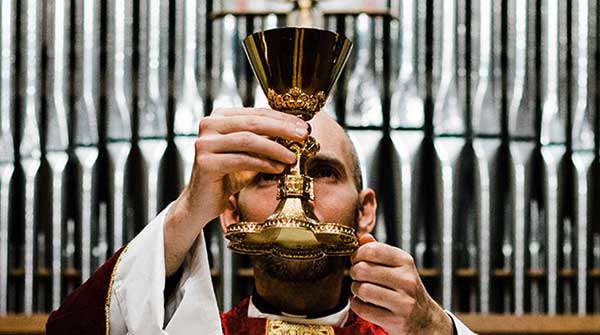 Pope Francis is open to the possibility of ordaining married men as priests. But don’t get too excited. The Catholic Church moves at glacial speed and a cadre of married priests won’t be joining the clerical ranks any time soon.
Pope Francis is open to the possibility of ordaining married men as priests. But don’t get too excited. The Catholic Church moves at glacial speed and a cadre of married priests won’t be joining the clerical ranks any time soon.
My initial reaction was cynical. Ordaining married men seemed like a convenient way to shut women out. But, upon reflection, I decided that was unfair. Married priests would be a good thing for Roman Catholicism.
When Francis made the comment to the German weekly newspaper Die Zeit, he was referring to viri probati. The term refers to married Catholic men of strong faith and proven virtue, and who, if ordained, would likely be financially self-sufficient. He wasn’t offering to remove the discipline of celibacy for seminarians or suggesting that celibate priests could marry.
There are already a small number of married priests in North America and Europe, although these men are not from the ranks of viri probati. In 1980, Pope John Paul II created a provision that allowed Protestant ministers who converted to Catholicism to receive Holy Orders. While the provision is now close to four decades old, married priests are still an exception, and their ordination represents a seismic shift in a church that’s resistant to change.
Even with the provision, there’s no automatic fast track into the priesthood for former Protestant clergymen. Requests go through a bishop to the pope and are decided on a case-by-case basis. In addition to spiritual and doctrinal considerations, matters of reputation and economics are part of the equation.
Father Dean Henderson of the diocese of Victoria, B.C., is a former Anglican priest. He came to Catholicism with his wife and five children. Henderson describes the journey towards the Catholic priesthood as lengthy and arduous. It was also a time of extraordinary scrutiny for him and his family.
Henderson has a staggering amount of responsibility. He is chaplain at the University of Victoria; an assistant priest at the cathedral; director of the vocations awareness team; oversees the marriage preparation program; is a member of the permanent diaconal formation team; and is in charge of the council for promoting marriage and family life.
Men like Henderson are a boon to a church suffering from a lack of clerical vocations. They’re filling in gaps in an institution that’s struggling with a lack of manpower. However, married clergymen present some unique challenges for a church with a celibate hierarchy.
A married priest, with a wife and family, costs more than a celibate priest. As congregations and Sunday collections dwindle, the church could shy away from ordaining married priests in the name of frugality.
It’s clear from Henderson’s responsibilities that the demands on a priest’s time are significant. Priestly ministry is not a nine-to-five job. The time away from family can negatively impact married and family life. And how would a church that prohibits divorce handle a marriage breakup amongst one of its priests?
Consideration must also be given to the priest’s wife, who deserves to share in some way in her husband’s relationship with the diocesan presbyterate. In Henderson’s case, the local presbyterate gradually welcomed his wife, Linda, inviting her to events that included mostly priests but also some other women. “The nature of presbyterial fellowship is increasing to including women where it never used to,” said Henderson.
The ordination of married men can foster inclusion of women in a patriarchal church. While not intentional, the wives of married priests may be playing an important role in bringing the perspective of women to the authority structures of the church. And while some may fear it, their presence could open the door for more meaningful involvement of women in all sorts of ministry, including positions of authority. (Of note, some dioceses, such as Victoria, already have women in key positions. In Victoria, women hold the positions of chancellor and financial officer.)
Any discussion on the subject of married priests must include a word on celibacy. In a culture focused on individual autonomy, self-gratification and sexual permissiveness, a celibate priesthood seems archaic.
In Henderson’s opinion, optional celibacy would increase attraction to the Catholic priesthood. Celibacy adds another dimension to the process of discernment; it’s difficult “to figure out if you can give yourself in celibate love for the rest of your life to serve in the church.”
As a married priest, Henderson believes he can help others understand and affirm the value of celibacy. “Theologically, celibacy is a different way of looking upon Christ’s love for the church with the emphasis on heaven, whereas the married state is the love of Christ grounded in reality on the earth. It is the complementary flip side of the love of God for his people.”
While married priests are part of the solution to the shortage of priests, they’re not the silver bullet. The shortage of celibate priestly vocations is a symptom of a larger problem. Society has changed dramatically in the last half century and the faithful are dwindling in numbers. “In every way, we’ve got to make significant changes in the way we do church,” says Henderson.
Hopefully, that change comes before the glaciers melt.
Louise McEwan has degrees in English and Theology. She has a background in education and faith formation.
Louise is a Troy Media contributor. Why aren’t you?
The views, opinions and positions expressed by columnists and contributors are the author’s alone. They do not inherently or expressly reflect the views, opinions and/or positions of our publication.


